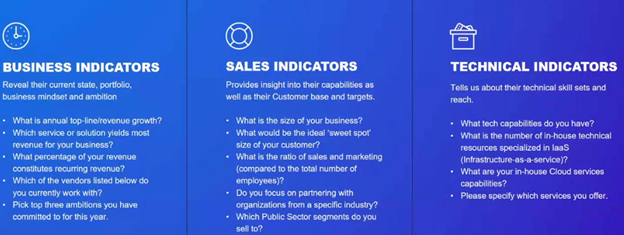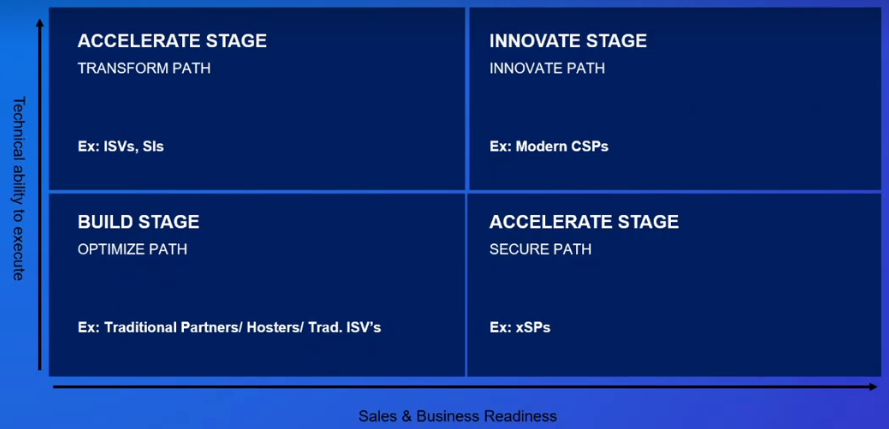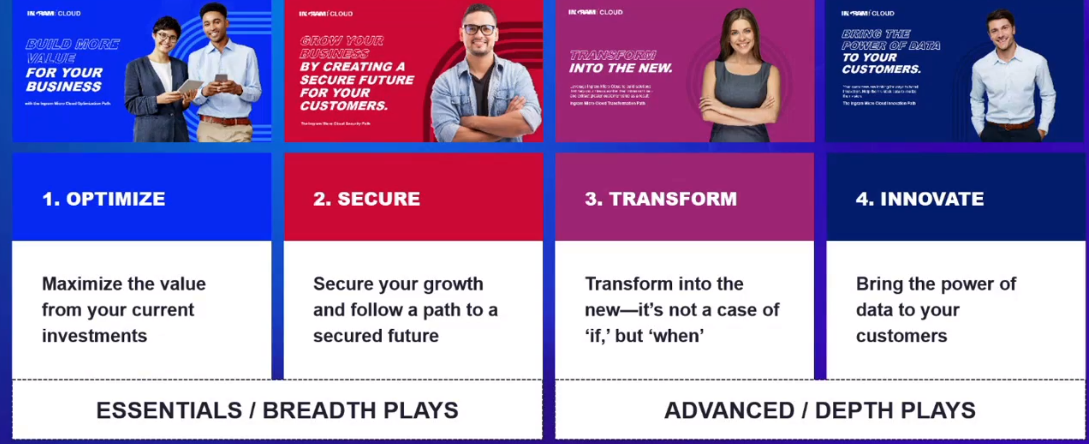IaaS Profiling Done Right Part 2

Welcome back! We hope you learned a lot from our previous blog, if not you can check that as well! In this blog we will tell you about our approach and introduce you to our dedicated portal. But that’s not all, you will also learn how to engage with different types of customers. Turn on your starship (read pc) and may the profiling force be with you!
What is our approach to customer profiling and how can you use our approach to your customers? We discovered that customer profiling and cloud have changed the standards on what it means to be successful. Now you need to make sure that you are taking the right approach in helping your customers to grow and succeed. Luckily for you we already figured it out and are happy to share it with you.
What is our approach to profiling?
We have developed a customer questioner and dashboard that collect, process, and present the data in different customer categories on both business and technical level. But how can you do that to? First you start with a digital survey that your customers can fill in. This survey is an easy way to collect data from your customers. Remember data is key just like a lightswords that slays stormtroopers (we know trademark but still?). The questions must be business, sales and technical related. The data you receive from this survey helps you to make those informed decisions and become more targeted.
Now you have the data, but the data is useless unless you do something with it. What we did is processing this data, giving it questions scores and weight. Once processed, the data is put in our internal dashboard that presents those insights into a useful presentation. This dashboard is important, because it takes the individual questions and put it into a format that can help you. You would not fly right into space without coordinates, would you? This whole process of data gathering and analyzing is our general approach. It forms the backbone of your approach and is crucial for your success in IaaS.
Asking the right questions
To make sure that you understand our approach we are going to take a deeper dive into it. Thereby it’s important to ask the right questions. As mentioned earlier. These questions must be business, sales and technical related. Let’s look into these questions that we use for our survey:

The first line of questions we call business indicators. These business questions focus on the business mindset, go to market strategy and the portfolio of offerings. By asking these questions you can reveal your customers current state, portfolio, business mindset and ambitions.
The next set of questions are sales indicators. These sales questions focus both internally as externally on your customers capabilities. But also provide you with insights into their capabilities as well as their targets.
The last set of questions are technical indicators. These questions give you more depth in the technical skill sets and reach of your customers. As you can see it’s important to ask the right questions to get the answers that are going to help both you and your customers. You need to know more about your customer business, their capabilities, and their intensions. Only then you can provide the best service.
This data shows you which customer is ideal to do business with. It ensures you that those customers are on the same page as you are. After you have the data processed, scored, and weighted, you can add the output into your dashboard. But why is this dashboard so important? We will explain it by giving an example.
Dangerous lightsword solution
If you gave someone a hundred lightswords containing a hunderd filled in surveys, and we said to you: ‘’tell me who your typical customer is?’’ It will surely cost you a lot of time to figure that out right? It will not only take a while to figure out how you can put out a survey from a lightsword, but it will also be time consuming figuring out who your typical customer is.
Or what if you have 50 customers that you manage and you want to know more about how many of your customers offer services, you will have 50 documents to go through. Using a dashboard which is taking the data and formulating those survey questions into useful information is much faster. This will also give you more insight in what type of customers you are working with, and what kind of support they need from you.
But what if you don’t you have a dashboard? Then you can create one by ordering Dynamics 365 or one of our other Power BI programs in our own Cloud Marketplace. We will assist you with information and trainings on how to use those systems. That way you can build your own dashboard and start profiling your customers.
Customer level quadrant
The next step is to present those insights. The easiest way to do that is by using a quadrant. Below you will find an example of a quadrant we use to organize customers into different levels.

This quadrant exists of 4 levels in which you can divide your customers. You can see that there are two axes, one is sales, and the other is technical related. If some of your customers is high on the sales spectrum, it means they are provisioned in their business readiness. If some of your customers Is high on the technical spectrum it means they are technical ready. There are three stages that a customer can be categorize into:
- Accelerate
- Build
- Innovate
These stages indicate where a customer might be in their cloud journey. The quadrants are as follow:
Build stage (optimize path)
This customer is lacking both in sales and technical capability. It means that this customer is just starting out in the cloud journey.
Accelerate stage (secure path)
This customer is good in sales, but not technical. It could mean that those customers lack the ability to execute.
Accelerate stage (transform path)
This customer does a great job in the technical aspect but is struggling in the sales aspect.
Innovate stage
At last, we have the innovate stage, whereby a customer is good at a technical level and does have the sales capabilities. This kind of customer may be ready to start leveraging new services and new technologies.
Now that you understand the quadrant, why are they so important? This quadrant helps you understand the difference between your customers and how you can target them more specifically. Based on this quadrant you can address customers IaaS needs from different solution paths. You may notice that under each stage there is an associated path. As you can see there are different solutions for your customer’s needs.
Engaging with different types of customers
But first let’s take a recap on what we have learned from profiling. What we now know is that profiling is important in helping your customers to be successful, you need to ask more deeper questions to your customer to profile them better and internal profiling and dashboarding gives you the data that you need to provide those solutions. Also, lightswords are not an efficient way to store data in.
As you are profiling it’s important to know the different types of customers you might engage with. Your approach should change, depending on the type of customer you are speaking with. Being able to categorize your customers is important because it will help you have those more in depth conversations and steer those conversations into what their needs and strengths are. If you find it hard to have those in-depth conversations, we can help you boost your technical intelligence or help you boost more sales with our IaaS solution journey.
To help you set up with profiling, we have created a full IaaS solutions journey, this helps you along the way. This journey exists of four solutions:
- Optimize
- Secure
- Transform
- Innovate

Optimize
This path is all about enabling your customer to optimize their current environment and helping them to build an IaaS practice. This path leads to your build stage.
Secure
This path is dedicated with helping you and your customers to navigate the complex security landscape that will secure your growth in the cloud. This path leads to the accelerate stage.
Transform
This path is aimed to transform your databases and applications working towards agility and innovation. This path leads to the other accelerate stage.
Innovate
This path is geared towards enabling you to become more data driven in making faster and better decisions. This path leads to the innovate stage, and maybe a better starship.
These paths are going to help your business be more valuable for your customers, because you will be offering them those tail end solutions. We will give you an example on why it’s so important to follow all these steps of profiling.
You want to buy a starship?
Imagen you are walking into a galactic starship dealer looking for a brand-new ship to save the IaaS universe. The sales alien comes up to you and starts trying to sell you a starship with no cannons. You will hear all the reasons why you should buy a starship without cannons, but that is not what you are looking for. At this moment you are immediately disengaged and aren’t listening anymore. At this point you or the sales alien is not winning today.
Would it be better if the sales alien asked you questions first, profiled you and understood what your needs are? Then he could have pitched a starship that would specifically fits your interest, and you could have won both that day.
More as a service part 2
Once you begin to know more about your customers, you can serve them better. But what if you don’t know exactly how to start? Luckily you can use our eBooks, which are going to help you start thinking about specific solutions or technologies at your level. If you want to know more about these eBooks and how to use them, you can click on the button below.
We can assist you in choosing the right eBook depending on your skill level and help you accelerate in IaaS and better serving your customers.
More information
Would you like to know how we can support you in your cloud journey? Please contact our IaaS team via iaas@ingrammicro.com or 32 2 254 99 50.
-
Category Growth & Best Practices
-
Written by Megan Romeis
-
Published on September 21, 2021
Megan Romeis, IaaS Global Practice Manager, Ingram Micro
Megan manages the IaaS portfolio and strategy, GTM enablement and vendor relations at Ingram Micro. As part of the Global Portfolio Management Team, her focus is on developing and building out the Ingram Micro’s global IaaS and PaaS strategy.































